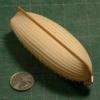-
Posts
13,301 -
Joined
-
Last visited
Content Type
Profiles
Forums
Gallery
Events
Everything posted by druxey
-
An interesting solution to the problem, Dan. What gold paint did you use, if I may ask?
- 238 replies
-
- leviathan
- troop ship
-
(and 2 more)
Tagged with:
-

Difference between a deadeye and a clump block
druxey replied to Captain Al's topic in Masting, rigging and sails
From the description, a clump block is what was earlier termed a 'thick' block. There were regularly proportioned blocks, as well as 'thin' blocks. The latter were, as implied, thinner for their length and were reeved with a lighter line than the regular version. Presumably 'thick' or 'clump' blocks carried lines of larger size than their 'normal' counterparts. -
The usual way to use rubber cement is to coat both surfaces to be glued, allow the solvent to dry, then press the parts together like contact cement. Until you press firmly, there is wiggle room to adjust. A piece of crepe rubber works just as well as your finger! A word of caution: after some years the rubber deteriorates and turns the card brown as well as loses adhesiveness.
-
Very impressive. Would dampening the houtbord help prevent it splitting while shaping it?
- 65 replies
-
- fish hooker
- fishing
-
(and 2 more)
Tagged with:
-
Mark: a small point about the knuckle moulding (between lower and upper counters): the lower edge of this moulding sits about an inch below the lower counter plank surface to form a drip edge. I discovered this from examining contemporary museum models. In the last photo it looks to sit about an inch above the planking.
-
Very informative and educational, as well as entertaining, Ab! Thank you.
- 65 replies
-
- fish hooker
- fishing
-
(and 2 more)
Tagged with:
-
Congratulations on your anniversary and a happy, healthy, year ahead, Alan!
- 125 replies
-
- 9 pound naval cannon
- 3d cannon barrel
-
(and 1 more)
Tagged with:
-
Looks terrific, Michael. Take care when working aloft!
- 2,214 replies
-
The lower photo (repeated) looks about right. I believe that it was Longridge who stated that this troublesome piece was shaped from solid rather than steam bent. I found that I had to slide that triangular piece in from above (if the hull is right side up!) and aft, down and forward, for a nice fit.
-
That seems weird! As you say, there is something odd going on.
- 125 replies
-
- 9 pound naval cannon
- 3d cannon barrel
-
(and 1 more)
Tagged with:
-
The kit is just trying to give the impression that Allan's posting shows. The 'netting' in the photo is not it!
-

Yamaha MT-01 by Dan Vadas - CARD - FINISHED
druxey replied to Dan Vadas's topic in Non-ship/categorised builds
Impressive, Dan! Well done. Aren't you going to build the rest of the Yamaha models as well? -
Brass often has a lacquer coating. Remove this with acetone and - voila!
- 125 replies
-
- 9 pound naval cannon
- 3d cannon barrel
-
(and 1 more)
Tagged with:
-
If you are using nothing but straight, parallel strips, you will probably not only have difficulties but will be unhappy with the results. The only surface you can satisfactorily plank with straight strips is the side of a house. Boats aren't that shape, unfortunately. However, it's your model and your decision!
-

Best Software for Deck Plank Design?
druxey replied to knightyo's topic in CAD and 3D Modelling/Drafting Plans with Software
All graphic programs have a big learning curve. Might the better route be to draw manually? Handling a long, flexible drafting curve is a much quicker learning process! -
Good question, Dirk. The English also made repairs and replacements easier by through-bolts that were forelocked. How early this practice began, I'm not sure.
- 1,035 replies
-
- royal katherine
- ship of the line
-
(and 1 more)
Tagged with:
About us
Modelshipworld - Advancing Ship Modeling through Research
SSL Secured
Your security is important for us so this Website is SSL-Secured
NRG Mailing Address
Nautical Research Guild
237 South Lincoln Street
Westmont IL, 60559-1917
Model Ship World ® and the MSW logo are Registered Trademarks, and belong to the Nautical Research Guild (United States Patent and Trademark Office: No. 6,929,264 & No. 6,929,274, registered Dec. 20, 2022)
Helpful Links
About the NRG
If you enjoy building ship models that are historically accurate as well as beautiful, then The Nautical Research Guild (NRG) is just right for you.
The Guild is a non-profit educational organization whose mission is to “Advance Ship Modeling Through Research”. We provide support to our members in their efforts to raise the quality of their model ships.
The Nautical Research Guild has published our world-renowned quarterly magazine, The Nautical Research Journal, since 1955. The pages of the Journal are full of articles by accomplished ship modelers who show you how they create those exquisite details on their models, and by maritime historians who show you the correct details to build. The Journal is available in both print and digital editions. Go to the NRG web site (www.thenrg.org) to download a complimentary digital copy of the Journal. The NRG also publishes plan sets, books and compilations of back issues of the Journal and the former Ships in Scale and Model Ship Builder magazines.


